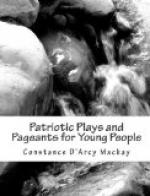DRAMATIC SILHOUETTE: LORDS OF THE FOREST
A white curtain of sheeting, or other similar material. A strong light placed behind the curtain throws into high relief the figures as they pass in significant procession. They are shadow silhouettes of a time long gone, of a race who now are shadows. Care should be taken that they move in exactly the right space, so that the shadows will not vary greatly in height or in bulk. First a chieftain passes, wonderful in feathers. Next a young brave, who, standing alone a moment, tries the taut string of his bow. Next an Indian maid, with a basket poised on her head. Then two young braves with fish slung on a pole between them. Then a group of Indian maidens. An Indian child or two. A squaw with fagots on her back. Another with a papoose. Then two Indians with a canoe, representing the portage of a canoe. Then a final group of young braves. The music, which begins as the chief passes, continues throughout the procession until the last Indian has passed, then ebbs and dies, growing fainter and fainter, till it ceases. Mac-Dowell’s “From an Indian Lodge” is suitable for this.
THE COMING OF THE WHITE MAN: TABLEAU
This tableau represents a woodland scene, and is supposed to symbolize the coming of the Norseman. A young Indian brave, with skins about his shoulders and hips, his black hair flying, his brown arms barbarically braceleted, stands poised, listening, and looking at a spot where the Norsemen are supposed to be making a landing, off stage. With one hand he shields his eyes. With the other he holds his bow. The tableau should suggest the wild freedom of an untamed spirit. For music, some bars of Grieg’s Norse airs.




